
|
|
| RAMPART STREET |
Introduction Main Library Site | Eye, Ear, Nose & Throat Hospital Pythian Temple | Duncan Plaza Charity Hospital | Rampart Street |
| Click on the images to view a larger version. Use your BACK button to return to this page. |
|
| "South Rampart Street is the Harlem of New Orleans. For a distance of several blocks it teems with a great variety of shops catering largely to the Negro population. Countless cafes and refreshment stands are in evidence, and music-store phonographs supply the visitor with an introduction to local Negro melody. The street, which is seen to its best advantage on Saturday evenings, when it is crowded with shoppers and pleasure-seekers has afforded material for numerous literary works. . . . "
Federal Writer’s Project (New Orleans, La.) New Orleans City Guide (Boston: Houghton Mifflin, 1938), p. 331 |
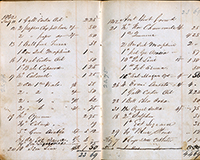 |
One of the city’s early hospitals was the Circus Street Infirmary located on South Rampart (the street’s name was changed in 1852) between Poydras and Perdido Streets. Started in 1841 by Drs. Campbell and Mackie, it remained in operation at least until 1878. The Infirmary building is no longer standing, but several landmarks in the history of jazz do remain in the 400 block—the Iroquois Theater, the Karnofsky tailor shop, the Eagle Saloon, and the recently renovated and reopened Little Gem Saloon.
Manuscripts Collection, Circus Street Infirmary Account Book, 1841-1842 [MS-171] |
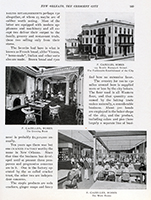 |
The 100 block, at least, of South Rampart Street appears to have been quite fashionable during the nineteenth century. The F. Cazelles store at 153 S. Rampart had been described in a 1902 auction advertisement as “a magnificent mansion . . . leased as a fashionable apartment house until September 30, 1902, at the rate of $2,400 per annum.” The Cazelles, who had moved back to Paris, finally sold the mansion, along with the adjacent buildings that comprised part of New Orleans Chinatown, for $61,500 in 1907. It was demolished at the same time as Chinatown, in October 1937. Just a few doors down from the Cazelles mansion stood the former home of Mrs. Thomas J. Semmes, described by the Daily Picayune in 1898 as “the center of a most cultured and refined circle, and all that is best in the world of letters and art. . . .”
New Orleans, Louisiana, the Crescent City: the book of the Picayune also of the public bodies and business interests of the place (New Orleans: Geo. W. Engelhardt, 1903-1904), p. 169 |
 |
The status of the 100 block of South Rampart is confirmed by the 1899 edition of Soards’ Elite Book of New Orleans. Subtitled A Directory of Selected Names of Those Whose Patronage Would Be Desirable, the volume lists Mr. & Mrs. Semmes and also the prominent physician Stanford Chaille as residents of the block.
Soards’ Elite Book of New Orleans (New Orleans: L. Soards, 1899), p. 117 |
 |
Alfred O. Smith operated the Chicago Hotel at 204-206 South Rampart Street “for the highest class colored people” from 1907 until 1914 or 1915. This page from the hotel’s guest register during April 1910 shows that the Williams and Stevens Stock Company stayed there while performing at the Temple Theater (in the Pythian Temple). They had previously appeared at the Theater’s formal opening on September 26, 1909.
Manuscripts Collection -- Chicago Hotel Guest Register, 1907-1912 |
 |
Advertisement for the Chicago Hotel and Restaurant, 1914.
Woods Directory: Being a Colored Cusiness, Professional and Trades Directory |
 |
Business card for the Chicago Hotel
Manuscripts Collection -- Chicago Hotel Guest Register, 1907-1912 |
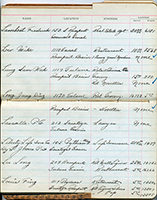 |
Some of the licensed Chinese businesses operating in the Chinatown section.
New Orleans Police Department, Report of Police Officers on Licenses Paid and Unpaid, 1922, |
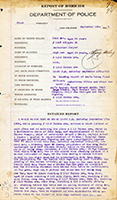 |
“ONE SHOT DEAD AS TONG WAR INVADES NEW ORLEANS” was the headline in the Times-Picayune on the day following the murder of Chin Soo just a few steps off South Rampart Street in Chinatown. Here is the New Orleans Police Department report on the crime.
New Orleans Police Department, Homicide Reports, 1925 |
 |
South Rampart Street Parade came out of New York City rather than New Orleans, but co-composer Ray Bauduc was a native of the Crescent City. The song captures the spirit of a local street parade and it quickly became a hit after its release in 1938.
Early Jazz Record Collection |
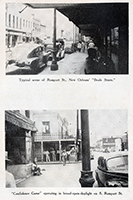 |
Two images from South Rampart Street that perhaps suggest a less enthusiastic view of the area than that presented by the 1938 City Guide, at least on the part of educator and sports journalist Champ Clark. What he characterized in 1942 as “New Orleans Beale Street” has more recently been summed up with these words from John Hasse, Curator of American Music at the Smithsonian Institution: "There is probably no other block in America with buildings bearing so much significance to the history of our country's great art form, jazz."
Peter Wellington Clark, Delta Shadows: a Pageant of Negro Progress in Orleans |
02_sm.jpg) |
The 200 and 300 blocks of South Rampart Street were mostly still intact when this photograph was taken in 1960, including the former Chicago Hotel on the corner across from the Oil and Gas Building. Some of the old buildings remain in place even today, but there are more high-rise buildings and parking lots than anything else. Off in the distance, though, on the far side of Poydras Street, the new South Market District is now being built. In the words of the project developers, it “combines stylish residences with exciting new retail, restaurants, and entertainment venues in the heart of Downtown New Orleans.” Yes -- the CBD is still changing!
Municipal Government Photographs Collection. Photographs Arranged by Street Names -- South Rampart Street, #2 |
|
Charity Hospital | Rampart Street |
|
|
|
|